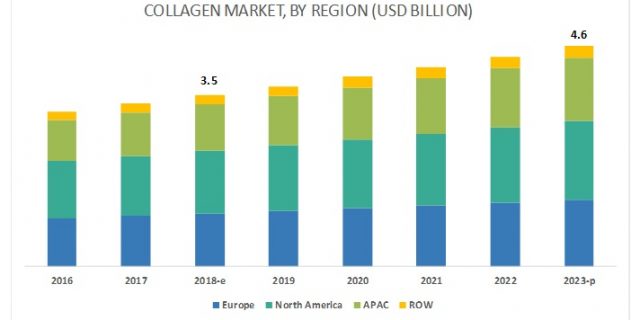
The report “Collagen Market by Product Type (Gelatin, Hydrolyzed Collagen, and Native Collagen), Source, Application (Food & Beverages, Pharmaceutical & Healthcare), and Region (North America, Europe, Asia Pacific, and Row) – Global Forecast to 2023″
The Collagen Market is estimated to account for nearly USD 3.5 billion in 2018 and is projected to reach a value of nearly USD 4.6 billion by 2023, growing at a CAGR of 5.2% from 2018. This is due to the increasing use of collagen and collagen proteins in the medical and pharmaceutical industries. Increase in demand for collagen and collagen products in the food & beverage and cosmetic industry has encouraged manufacturers to provide better protein-based products, which in turn, has contributed to the market growth.
Browse 95 market data Tables and 34 Figures spread through 125 Pages and in-depth TOC on“Collagen Market – Global Forecast to 2023”
Download PDF Brochure @ https://www.marketsandmarkets.com/pdfdownloadNew.asp?id=220005202
By product type, the gelatinsegment is estimated to account for the largest share in the collagen market in 2018.
On the basis of product type, the gelatin segment is estimated to dominate the collagen market in 2018. Gelatin is widely used in foods to improve elasticity, consistency, and stability. It also helps to normalize gut hormones in obese people. Thus, due to rising health awareness, gelatin is being preferred by food manufacturers to produce nutritious food products. Gelatin is increasingly used in the food & beverage industry to make gummy candies, puddings, confectionery, and gelatin desserts.
The collagen market is witnessing a strong growth due to the increasing use in the food & beverage industry.
Collagen in the form of gelatin is high in protein, fat-free, cholesterol-free, and low in calories, which makes it a label-friendly ingredient that consumers know and trust. It is a key functional ingredient in many food products. It is also an important component in confectionery items such as marshmallows, gummy candy, and fruit snacks. The dairy industry makes extensive use of gelatin in the manufacture of sour cream, yogurt, ice cream, cheese, and specialty desserts, while meat processors depend on the binding properties of gelatin for the production of specialty meats, pates, and luncheon meats. Thus, these factors are projected to drive the collagen market.
Europe is estimated to dominate the collagen market in 2018.
Europe is estimated to account for the largest market share in the collagen market in 2018. The region has witnessed many collagen-infused drinks launched by the manufacturers, such as cappuccino collagen and soy collagen. They are either marketed as components of protein blends or in combination with fruits. The rising usage of collagen in wide varieties of food items and beverages along with the changing consumer preferences are accelerating the market growth. Moreover, the preference for minimally invasive or non-invasive technologies and the increasing use of collagen by biomedical industries in the developed countries are further driving the market growth.
Speak to analyst @ https://www.marketsandmarkets.com/speaktoanalystNew.asp?id=220005202
On the basis of product type, the market segmentation includes gelatin, hydrolyzed collagen, and native collagen. The gelatin segment is estimated to account for the largest share in the collagen market in 2018, and the same trend is projected to continue during the forecast period. Gelatin is widely used in foods to improve elasticity, consistency, and stability. It also helps to normalize gut hormones in obese people. Thus, due to rising health awareness, gelatin is being preferred by food manufacturers to produce nutritious food products. Gelatin is increasingly used in the food & beverage industry to make gummy candies, puddings, confectionery, gelatin desserts. It is also added in sauces and soups to thicken the consistency and provide a better product to the consumers.
The global collagen market, on the basis of source, is segmented into bovine, porcine, and marine & poultry. The marine & poultry segment is projected to witness the fastest growth from 2018 to 2023. The demand for collagen protein in food products is one of the major factors driving the demand for marine collagen in the global collagen market. Marine collagen is a fibrous protein derived from different parts of marine animals such as fish, jellyfish, sponge, Mollusca, and other invertebrates. Short amino chains promote high bioavailability; they help the peptides to pass through the intestinal wall into the bloodstream easily. Increase in the consumption of processed and health-based food products is also driving the marine collagen market. Additionally, the demand for processed food products in developing countries is driven by the increase in the disposable income of consumers.
Based on application, the market segmentation includes food & beverages and pharmaceutical & healthcare. The food & beverages segment is projected to witness the fastest growth from 2018 to 2023. The increasing health awareness and rising purchasing power of consumers have led to the increased usage of collagen by manufacturers in premium food & beverage products. Among all the food & beverage food items, nutritional products hold the maximum market share. This is due to the rise in demand for sports and nutritional products and an increase in protein intake by athletes and fitness enthusiasts.
Inquiry Before Buying @ https://www.marketsandmarkets.com/Enquiry_Before_BuyingNew.asp?id=220005202
Key Market Players
The key players in this market include Gelita AG (Germany), Nitta Gelatine, Inc. (US), Weishardt Group (France), Darling Ingredients (US), Nippi Inc. (Japan), Vinh Hoan Corporation (Vietnam), Juncà Gelatines, S.L.(Spain), Lapi Gelatine S.p.a. (Italy), Gelnex (Brazil), Vital Proteins (US), Baotou Dongbao Bio-Tech Co., Ltd. (China), RABJ Co., Ltd (Japan), Connoils (US), Nutra Food Ingredients (US), and Italgelatine S.P.A (Italy). These players are focusing on improving their presence by undertaking acquisitions, expansions, and developing products specific to the requirements of consumers and their preferences. These companies have a strong presence in Europe and North America.